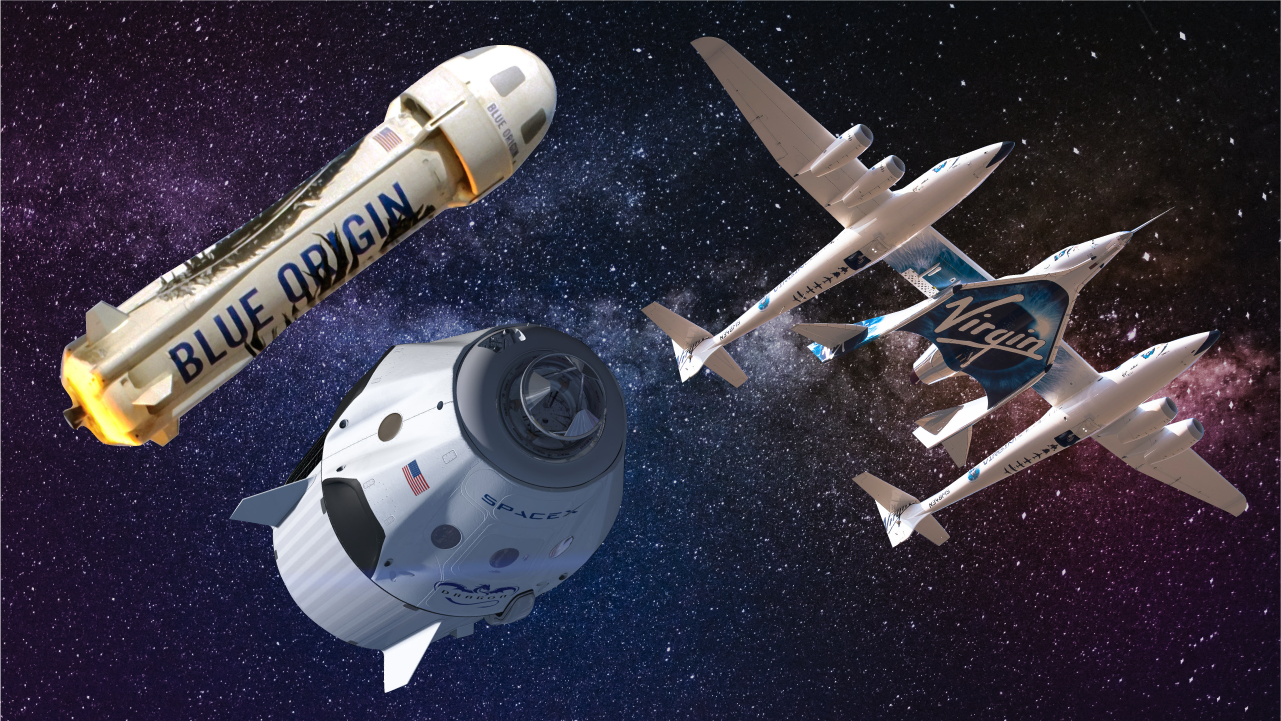- Virgin Galactic just flew its SpaceShipTwo over 50 miles above the Earth’s surface – putting the company one step closer to sending civilians to space.
- Billionaire-owned companies like SpaceX, Blue Origin, and Virgin Galactic are all in a modern space race to make space travel more accessible to private citizens.
- It’s estimated that space tourism could generate $1.6 billion in revenue in the next decade.
Billionaires Elon Musk, Jeff Bezos, and Richard Branson all want to send private citizens to space. Their respective companies, SpaceX, Blue Origin, and Virgin Galactic are dedicated to making space travel and space tourism more accessible.
Narrator: SpaceX, Blue Origin, and Virgin Galactic are in a modern space race. Similar to when the United States and the Soviet Union competed to get astronauts on the moon, these billionaire-run companies are racing to bring people like you and me to space. But how will they do it?
Let’s start with Blue Origin, the passion project of Amazon CEO Jeff Bezos. Blue Origin’s focus is on commercial space flight, or space tourism. It plans to shoot a booster rocket with an attached passenger capsule to 60 miles above the surface into sub-orbital space. At the top of the rocket’s arch, the capsule will detach, and for about four minutes, passengers will experience weightlessness. They’ll be allowed to unbuckle their seat belts and float around the cabin, looking out the window at the curvature of the Earth. The capsule will then start to fall back into the atmosphere, and parachutes will deploy to bring it down slowly. The whole trip only lasts about 11 minutes. A ticket on Blue Origin’s New Shepard will likely cost more than $200,000. That’s over $18,000 a minute. Blue Origin has tested the New Shepard rocket nine times, and the company still hopes to send civilians into space in 2018.
Virgin Galactic also aims to make commercial space travel accessible. But the vehicle it’s using looks quite different. Virgin Galactic’s SS Unity looks more like a plane than a rocket. The ship is made up of the WhiteKnightTwo, a carrier airplane, and SpaceShipTwo, a passenger spaceship. SpaceShipTwo can carry six passengers and two crew members. The passenger ship detaches from the carrier plane about nine miles above the Earth’s surface. The ship then fires its rocket engines to blast about 50 miles further until it reaches sub-orbital space. Similar to Blue Origin, passengers will experience four to five minutes of weightlessness before the ship re-enters the atmosphere. The total trip should last about two and a half hours. Virgin Galactic has conducted three rocket-powered test flights of the SS Unity and it hopes to get its first passengers to space by the end of 2018. Founder Richard Branson will be one of the first people to take the trip. And Virgin Galactic has already sold 700 tickets for future flights, costing $250,000 each.
Elon Musk's company SpaceX also wants to send people to space. SpaceX's ultimate goal is to establish colonies on other planets. The ship SpaceX intends to send to Mars could hold 100 people, and the ride would be a lot longer than four minutes. But SpaceX also plans to send people to space on their way to other earthly destinations. The Big Falcon Rocket will briefly enter space to make long-distance travel shorter. Traveling by rocket from New York to Tokyo, for example, would only take 37 minutes. And it would take no more than an hour to get anywhere on Earth.
Blue Origin, Virgin Galactic, and SpaceX are major players in the modern space race, but there are even more companies out there. It's estimated that space tourism could generate $1.6 billion in revenue in the next decade. So no matter which company crosses this finish line first, there will inevitably be another race. After all, space is infinite.
EDITOR'S NOTE: This video was originally published on September 21, 2018.

